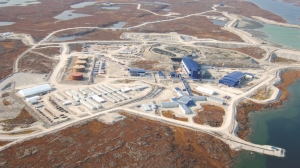Like many companies clinging to the lifeboats in 2009, Harry Winston Diamond (HW-T, HWD-N) was relieved to see the dawn of 2010.
The financial storm that submerged diamond prices also forced the company and its senior partner Rio Tinto (RTP-N, RIO-L) to shut down production at Diavik diamond mine in Canada’s Northwest Territories from July 14-Aug. 24. Ownership is divided between operator Rio Tinto (60%) and Harry Winston (40%).
Signs of a sustainable recovery in September prompted management to cancel a proposed winter shutdown scheduled for Dec. 1- Jan., 11 but third-quarter results for fiscal 2010 showed just how much pain the first shutdown had already inflicted on the balance sheet.
The company posted a net loss in the third quarter ended Oct. 31 of US$0.2 million (or nil per share), compared to net earnings of US$71.9 million (US$1.17 per share) in the third quarter of the prior year, and a net loss of US$24.5 million (US$0.32 per share) in the second quarter.
Consolidated third-quarter sales were US$74.8 million, compared to US$148.6 million for the comparable quarter of 2008, resulting in a 62% decrease in gross margin and a loss from operations of US$4.9 million.
The mining segment recorded sales of US$20.8 million, a 77% drop from US$90.7 million in the comparable quarter of the prior year. The fall in sales was due to the double whammy of a 75% decrease in volume of carats sold in the third quarter and a 9% decrease in rough diamond prices.
Indeed, the company held just one rough diamond sale in the third quarter compared to three in the same quarter of 2008.
Nevertheless, Robert Gannicott, Harry Winston’s chairman and chief executive, struck a remarkably upbeat note when announcing the financial results on Dec. 9.
“Diavik production is set to increase, rough diamond prices continue to rise, and retail sales have seen substantial improvement, led by the Far East, including Japan,” he maintained. “If U.S. recovery takes hold it will inevitably produce incremental demand for diamond products.”
The company noted that the rough diamond market “continues to strengthen as sustained demand for polished diamonds from the Far East and India, along with reviving interest from the U.S., have contributed to lower inventory levels amongst manufacturers.”
Rough diamonds remain in short supply, allowing diamond producers like Russia to cut back accumulated inventory without affecting the healthy price increases achieved since the first quarter, the company added.
In addition, polished diamond demand “remains healthy with shortages appearing in popular ranges.” Inventories of polished diamonds have been depleted as manufacturers earlier in the year responded to market conditions and the ongoing scarcity of rough diamonds. “These conditions have allowed manufacturers to achieve higher polished prices and negotiate more favourable credit terms,” Harry Winston declared.
While signs of the recovery are modest, the “tone in the U.S. and European markets indicates that the worst of the global recession’s impact appears to have passed. The increase in commodity prices has helped to bolster a modest renewal in consumer demand for luxury goods from the Russian and Middle Eastern markets.”
Looking ahead, the rough diamond market continues to experience a robust recovery from the extreme market lows seen in the first quarter of the year and pricing has improved significantly. The current tone in the market has encouraged diamond producers to sell-down inventory, but this has not led to lower prices.
Harry Winston says it plans to hold three rough diamond sales in the fourth quarter (for a total of eight in fiscal 2010) compared to two rough diamond sales in the fourth quarter of 2008 (and total of nine for fiscal 2009).
The plan for calendar 2010 envisions production of about 7.8 million carats from the processing of 2.1 million tonnes of ore. The estimate for calendar 2009 is unchanged at 1.4 million tonnes of open-pit ore mined, the majority of which will come from the A-418 kimberlite pipe, with the remaining production coming from the A-154 south open pit. Total carat production is expected to be roughly 5.5 million carats on a 100% basis.
In 2010, open-pit mining from A- 418 supplemented by A-154 South is expected to be the primary source of ore. Underground mining is expected to start in the first calendar quarter, with ore sourced mainly from the A-154 South kimberlite pipe. Total open-pit ore mined is expected to be 1.4 million tonnes and total underground is expected to be 0.7 million tonnes.
In Toronto, Harry Winston is trading at $10.45 per share, close to its 52-week high of $11.13 per share. It sank to a 52-week low of $2.19 per share on March 9.


Be the first to comment on "Harry Winston Hopes For Better 2010"